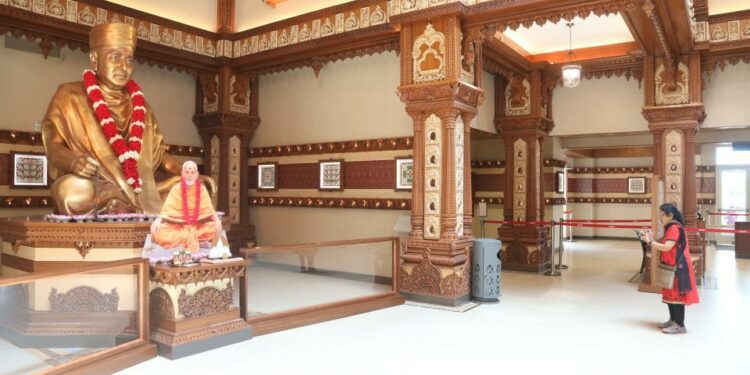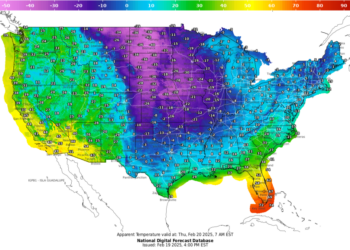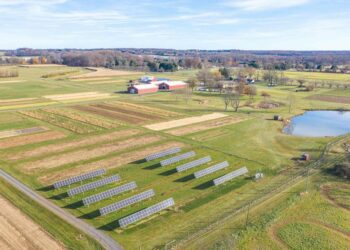If you’ve ever wanted to visit India, hop on the New Jersey Turnpike. When you reach Main Street in Robbinsville, about a half-hour outside of Trenton, a gold-topped spire will peek above the skyline.
Head toward it, and you arrive at the largest Hindu temple in the United States and among the largest in the world.
The BAPS Swaminarayan Akshardham temple rises 19 stories above the ground and sprawls over 180 acres on a campus big enough to hold six Yankee Stadiums. Since opening last fall, its unique blend of grandeur and spiritualism has attracted thousands — not only Hindu worshippers but also local residents and tourists from around the world.
It’s well worth the 90-minute drive from the George Washington Bridge to see this immense tribute to Hindu art and culture. On a recent late summer morning, I made the trek to Robbinsville myself.
Here’s what to know if you are going.
After scoring a parking spot in the stadium-sized lot, I headed to the main entrance, where I found myself surrounded by elaborate bronze statues, decorative pillars and soaring arches. Tourists clad in brightly colored sarongs weaved around the intricate architecture.
It was hard to believe I was still in New Jersey. A step into the BAPS complex feels like a journey to the other side of the world.
I was unsure where to look at first. I had the distinct sensation I had stepped into a giant work of art. One difference: Everything here seems to have a religious resonance.
Fortunately, I had a guide to show me around: Darshan Patel, an attorney who volunteers at the temple in his spare time and was eager to share his knowledge.
Building the BAPS Robbinsville temple: 12 years, 12,500 volunteers
He’s not alone. Members of the BAPS community are known for their selfless service, or “seva.” It’s a central form of devotion in the Hindu faith, Patel told me. More than 12,500 volunteers came from around the world to help construct this site over the course of 12 years. Some visited for days or weeks. Others, like Patel’s parents, relocated for years.
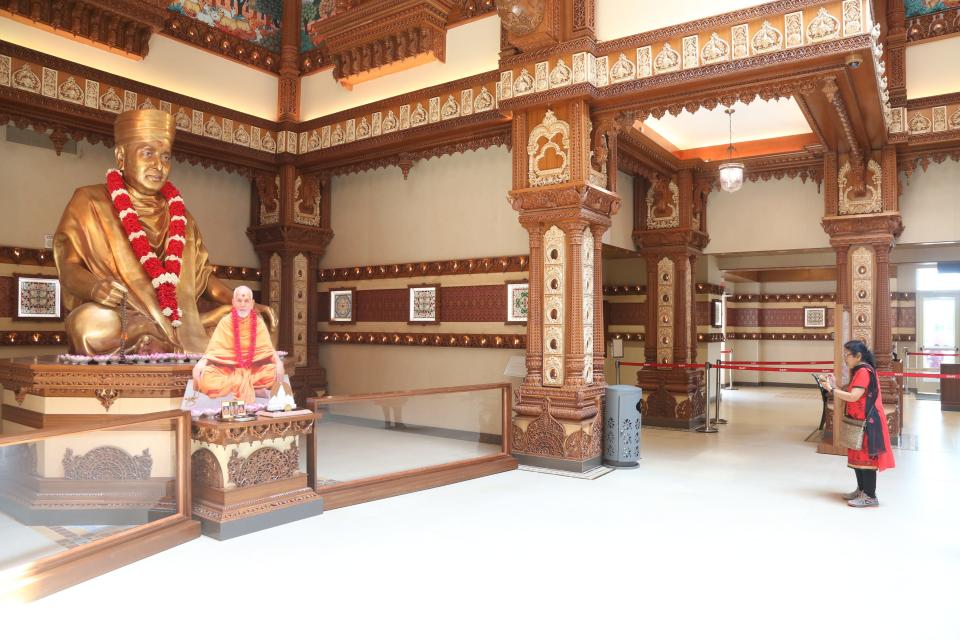

Robbinsville, NJ — August 2, 2024 — A tour starts at the visitors center. Completed and encouraging visitors of all faiths to tour it’s artistic detail carved in marble, BAPS Swaminarayan Akshardham, located in Mercer County, is the largest Hindu temple on this side of the world.
Bochasanwasi Shri Akshar Purushottam Swaminarayan Sanstha, known as BAPS, is a sect of Hinduism that follows the teachings of Bhagwan Swaminarayan, a Hindu leader born in the 18th century. It was one of his successors — the fifth spiritual leader of BAPS, Pramukh Swami Maharaj — who envisioned a series of temples around the globe that would inspire people, granting visitors a sense of peace and serenity.
BAPS, which has been in North America since 1974, has built elaborate outposts around the country, with temples in Atlanta, Chicago, Los Angeles and other areas with large Hindu communities. But Robbinsville is distinguished by its massive scale and grand architecture.
It’s no accident that this location was chosen for this particular temple: With its large South Asian communities, New Jersey has the largest concentration of Hindus of any state — almost 300,000 people, or about 3% of the total population.
Starting off: A bronze colossus of Bhagwan Swaminarayan
I met Patel at a 49-foot bronze figure near the entrance. Standing out in the crowd with a crisp white shirt, he explained that “statue” was not the right word for this colossus. It is a “murti,” a sacred image representing Bhagwan Swaminarayan. The BAPS founder stands on one leg in a yogic posture with arms stretched to the heavens.
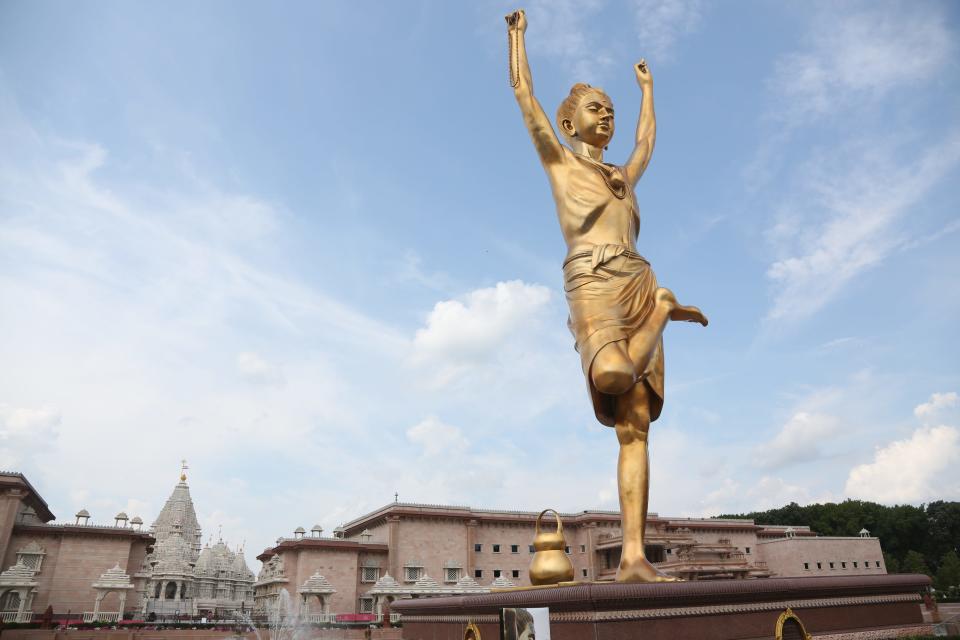

Robbinsville, NJ — August 2, 2024 — Visitors come to pray to the statue of Nilkanth Varni, who became known as Bhagwan Swaminarayan, the spiritual leader of a denomination called Swaminarayan Sampradaya. Completed and encouraging visitors of all faiths to tour its artistic detail carved in marble, BAPS Swaminarayan Akshardham, in Mercer County, is the largest Hindu temple on this side of the world.
Hailed as a social reformer and revered as a supreme being by his followers, Swaminarayan is honored here for the 8,000-mile walk across India he is said to have made as a teen to inspire people to live a moral life. His biography is a lesson of service to humanity, Patel said.
From the murti, we strolled around an artificial pond. Patel explained that it is a Brahma Kund, an adaptation of a traditional, tiered well. This one contains water from over 300 rivers in India and from all 50 states in the U.S.
The blending of the world’s waters signifies unity, Patel said. People in ancient India often would step down into such pools to pray. The water symbolizes life and renewal. Surrounding the pool in Robbinsville are bronze sacred images representing the rivers of India. (While visitors are encouraged to pause and reflect at this spot, it is for display only; no one is permitted in the water.)
BAPS Welcome Center is its own work of art
Our next stop is the Welcome Center, which in several theaters provides an overview of the temple and an explanation of Hindu religion and philosophy. A majestic foyer designed in Burmese teakwood, with beautifully carved pillars and panels, the center itself is a work of art. It is illuminated with over 2,700 traditional lamps and a skywell to recall the festival of Diwali, the Hindu holiday of lights.
The goal is to offer guests a proper welcome. “In Hindu culture, hospitality is very important,” Patel told me.
The Robbinsville complex is more than a place of worship. It’s designed for those interested in Hindu art and also serves as a cultural and spiritual hub for the area’s Hindu community. “This is a place that brings people together to celebrate Indian American identity,” Patel explained.
Many of the thousands who have come to see the temple since it opened are not Hindu, he said, but local residents or tourists of other backgrounds inspired to come by curiosity and wonder.
Among the sightseers I saw that day were a busload of tourists from Nepal along with dozens of young couples or families. Some visitors were in jeans; others sported sarongs, the traditional Indian garb.
The Akshardham: Soaring spires and 10,000 statues
The complex has two mandirs, or temples. A smaller, traditional Hindu mandir, which offers a more intimate experience, was completed in 2014. It is outside the Welcome Center and adorned with floor-to-ceiling carvings and statues. Daily services take place here, and visitors are welcome.
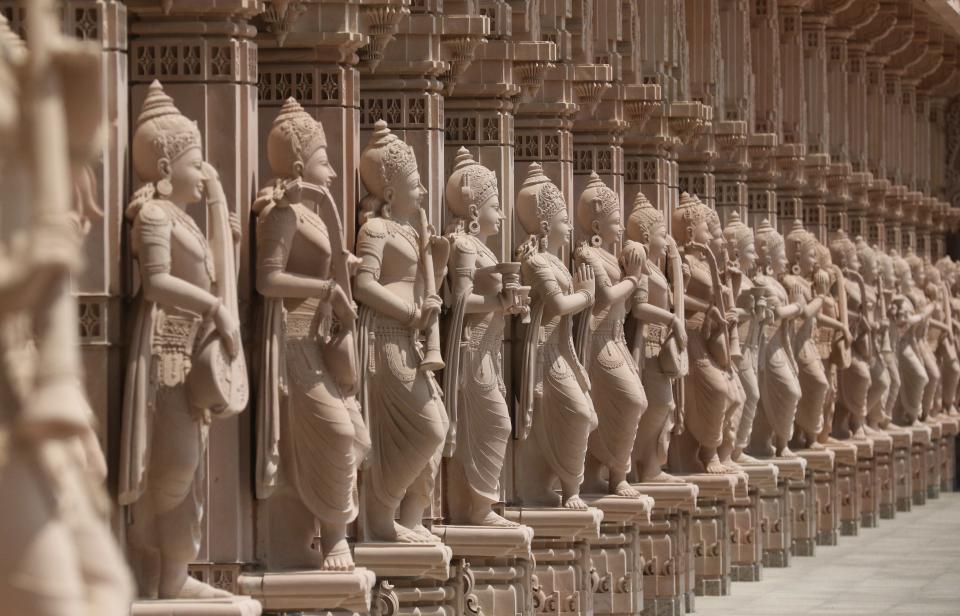

Robbinsville, NJ — August 2, 2024 — Completed and encouraging visitors of all faiths to tour it’s artistic detail carved in marble, BAPS Swaminarayan Akshardham, located in Mercer County, is the largest Hindu temple on this side of the world.
The campus’ centerpiece is a larger temple, called the Akshardham, which measures almost 90,000 square feet, reaches 191 feet into the sky and was made from 1.9 million cubic feet of marble and limestone. Construction, which began in 2011, was a global effort that spanned more than a decade. Artisans created some of the traditional stone carvings in India, and others were brought in to do the work here in Robbinsville.
Granite, limestone, marble and other materials featured in the temple were imported from Italy, Bulgaria and Greece, among several other countries, symbolizing the idea that the world is one family. Stones were quarried and shipped to India, where they were carved, arranged and packaged. Finished materials were then brought to New Jersey and assembled piece by piece like a jigsaw puzzle.
We waited in line to enter, and once inside the ornate Akshardham, we were asked to remove our shoes and put away phones and cameras, out of respect. Though the floors are heated in the winter, this reporter recommends that visitors wear socks.
Every inch of the temple tells a story
Almost every inch of space inside the temple tells a story: Ceilings, domes and walls pay homage to Hindu saints or convey symbolic messages. The domes — including what the temple says is the largest elliptical dome ever constructed from stone — depict the rivers of India. Five spires rise from the temple, and beneath each is a tableau depicting Bhagwan Swaminarayan at various stages of his life.
The temple features murtis of Swaminarayan’s successors that tell their tales, as well as sanctums that portray various forms of the divine in the Hindu faith. Hindus believe in one divine entity, but every Hindu community worships a different manifestation. For the BAPS Swaminarayan community, that divinity is embodied in its founder.
Many of the 10,000 intricately carved marble statues inside the Akshardham, the main mandir, depict musicians playing instruments, stories from ancient texts and individuals from Hindu history. Elephants and peacocks are also common motifs, the peacock associated with grace and elephants representing humility and wisdom.
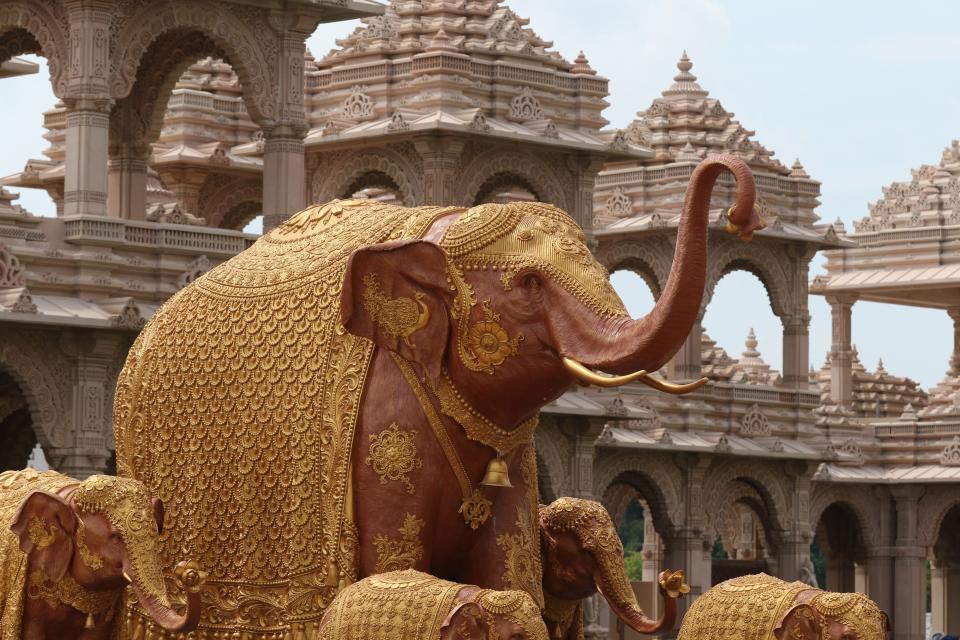

Robbinsville, NJ — August 2, 2024 — Elephants are a sacred symbol in the Hindu religions, representing loyalty, power, wisdom, and fertility. Completed and encouraging visitors of all faiths to tour it’s artistic detail carved in marble, BAPS Swaminarayan Akshardham, located in Mercer County, is the largest Hindu temple on this side of the world.
Patel pointed to carvings of Swaminarayan from different sects and shared the stories behind them, parables of harmony and inclusion that reflected the overarching theme of the temple. On its foundation are an assortment of carvings and quotes from Eastern and Western thinkers alike, including Albert Einstein and the Rev. Martin Luther King Jr. Designers wanted to convey universal values of peace, equality and justice even as they celebrated Indian American identity, Patel said.
Standing in the plaza facing the temple, I was struck by the sense of serenity this massive space somehow offers. A throng of visitors filled the square, but everyone seemed awed by the surroundings.
That’s appropriate. In Sanskrit, “mandir” means “place where the mind becomes still,” Patel said. Pramukh Swami Maharaj, the late spiritual leader of BAPS who directed the construction of this temple, dreamed that it would become a place where people of all backgrounds could seek solace.
As I glanced around the plaza at the clusters of visitors taking in the beauty of the scene, quietly reflecting, it was clear: His vision had come to fruition.
————————————–
Planning your visit to BAPS Robbinsville
Where it is: The BAPS Swaminarayan Akshardham, at 112 N. Main St. in Robbinsville, is 65 miles southwest of Manhattan.
Hours: The campus is open to visitors every day, except Tuesdays, from 9 a.m. to 7:30 p.m.
Tickets and time slots: Admission is free. But on weekends, national holidays and select Hindu holidays, visitors are required to register for a reservation time slot and will be allowed entry no earlier than 30 minutes before and no later than 30 minutes after the chosen slot. Visit usa.akshardham.org to make a reservation.
How long will you need? Visitors should allot two to 2½ hours. The temple offers guided and self-guided tours.
A highlight of any visit is the midday arti ceremony, performed daily at 11:15 a.m. This is an ancient Hindu offering made by waving a lighted wick before sacred images, accompanied by a musical prayer.
Food: No food or drinks can be brought onto the campus, and none are allowed in worship areas. On-site, the all-vegetarian Shayona Cafe offers authentic Indian cuisine. It’s open from 11 a.m. to 8 p.m.


Robbinsville, NJ — August 2, 2024 — Completed and encouraging visitors of all faiths to tour it’s artistic detail carved in marble, BAPS Swaminarayan Akshardham, located in Mercer County, is the largest Hindu temple on this side of the world.
Visitor etiquette:
Visitors must abide by a dress code: Tops must cover the shoulders, chest and upper arms. Shorts, skirts and dresses must be at least knee-length. Shoes should be removed before entering either of the temples.
Photos and video may be taken for personal use, except in areas of worship. Commercial photography or videography, including shoots for weddings, fashion shoots or other events, is prohibited.
Mobile devices must be kept silent on the premises.
Service dogs are allowed, but not pets.
Public transit options:
From New York or Newark Penn Station, take the NJ Transit Northeast Corridor rail line to Princeton Junction station.
From Newark Airport, take the AirTrain from your terminal to the Newark Airport rail station. From there, take the Northeast Corridor line to Princeton Junction.
From the New York Port Authority bus terminal, take the Coach USA (Suburban Transit) line No. 300 bus to the Hightstown, New Jersey, station.
From Princeton Junction or Hightstown, the temple is about a 15-minute ride by taxi or ride-hailing service.
Looking for more to see? In the Robbinsville area, also visit the Oasis Family Farm, Six Flags Great Adventure, Sayen House & Gardens or the massive Grounds for Sculpture garden in nearby Hamilton.
Where to stay: Options include Hampton Inn & Suites Robbinsville, Homewood Suites by Hilton in Hamilton, and the Hilton Garden Inn Hamilton.
Deena Yellin covers religion for NorthJersey.com. For unlimited access to her work covering how the spiritual intersects with our daily lives, please subscribe or activate your digital account today.
Email: [email protected]
X/Twitter: @deenayellin
This article originally appeared on NorthJersey.com: Visitor’s guide to BAPS Swaminarayan, the biggest Hindu temple in NJ
Source link : http://www.bing.com/news/apiclick.aspx?ref=FexRss&aid=&tid=66f3e710e6674099846de7723dfc9ba5&url=https%3A%2F%2Fwww.yahoo.com%2Flifestyle%2Fvisiting-biggest-hindu-temple-usa-094346606.html&c=5176688829506587429&mkt=en-us
Author :
Publish date : 2024-09-24 22:42:00
Copyright for syndicated content belongs to the linked Source.

